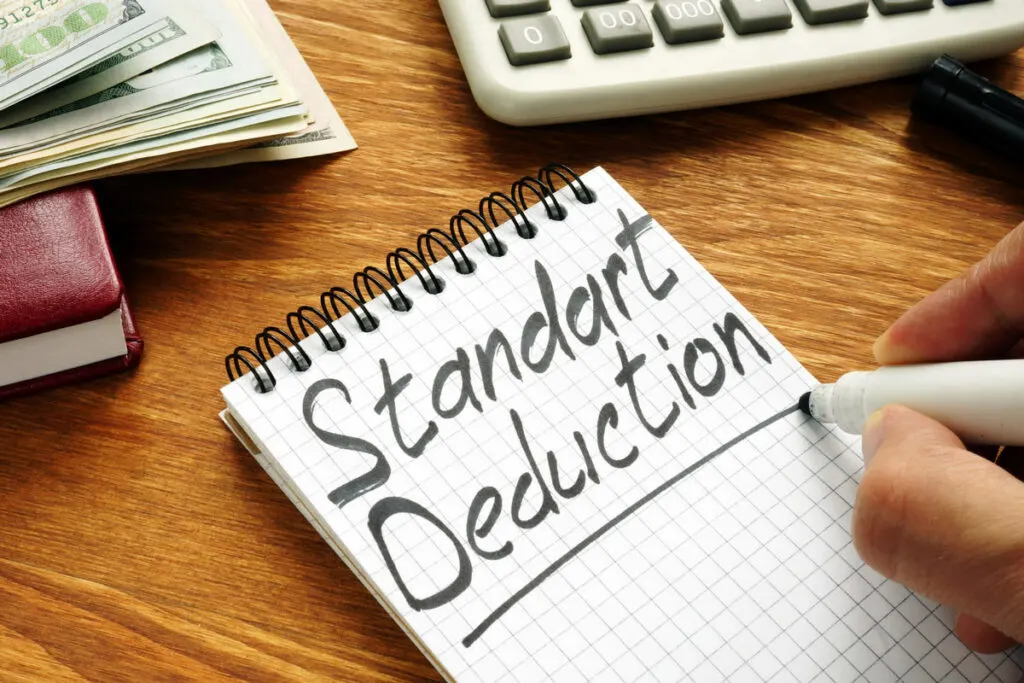If you read much on this site, you’ll notice that I’m always telling people to track their miles and expenses. It makes a tremendous difference when tax time rolls around.
But what if you don’t deliver that much? What if this is a part-time gig and expenses don’t add up to the $14,600 standard deduction (2024)? Isn’t it just a waste of time?
Which is better for a 1099 independent contractor for gigs like Doordash, Uber Eats, Instacart, Lyft, Uber, Grubhub, or others? Should you itemize or take the standard deduction?
Read on, and you’ll understand why it doesn’t matter which type of tax deduction you take. We’ll explain why you should track your mileage and expenses regardless. We’ll discuss:
- The difference between business expenses and tax deductions
- Why you can claim your expenses regardless of taking the standard deduction
- Lessons and takeaways from this.

About this article
The purpose of this article is to discuss how standard and itemized deductions impact your delivery driver taxes. It’s part of a series of articles about taxes for gig economy contractors. We’ll link to other articles in the series where appropriate, and you can see a complete list of articles at the end.
This is not tax advice, and you should not take it as such. The intent is to educate and explain how taxes work for gig workers. We only write about taxes in the United States. You should seek a tax professional who can guide you in your specific situation and understands your local and national tax rules.
The difference between business expenses and tax deductions
There’s a lot of lousy tax advice out there, especially on social media. One of the worst bits of advice is that you don’t need to track expenses because of the standard tax deduction.
People who tell you that make one critical mistake: They don’t realize that we’re talking about business expenses, not tax deductions. Those are two different things and are handled differently in your taxes.
When you agreed to be an independent contractor for gig economy companies (Doordash, Instacart, Uber, Lyft, Uber Eats, etc.), you agreed to provide services as a business. You’re not an employee.
As a result, you file taxes as a business. That changes everything about how you write off the cost of doing business.
The root of the error comes from how the standard tax deduction works. For personal tax deductions, you can choose between itemizing all of your tax deductions or taking a lump sum standard deduction. In 2024, that deduction for single filers is $14,600. If your deductions don’t add up to more than $14,600, itemizing doesn’t make sense.
That dynamic creates confusion for people who mistake business expenses for business deductions. Tax deductions are related to personal finances. They involve things you’re allowed to write off, like mortgage interest and charitable donations.
Business expenses are part of your business finances. They go into a different part of the tax process and should not be included in the tax deduction discussion.
Why you can claim business expenses on top of the standard deduction

You can claim your miles and business expenses, even when taking the standard deduction because you claim expenses elsewhere on your taxes.
There’s a process you follow when filling out your 1040 form.
- Add up income.
- Subtract adjustments and tax deductions
- Figure out your tax bill
- Apply payments and credits to determine a refund or what’s owed.
Business expenses are claimed in the income part of the tax process.
This is because, as a small business owner, your business income is your profit, or what’s left over after expenses.
In other words, you must subtract expenses from what you earned from gig companies to get your income.
All of that happens with IRS form Schedule C. Add up the money you made from customer tips and from gig companies like Uber, Doordash, Instacart, Grubhub, Lyft, and others. Put that on Schedule C. Also, put down your business expenses and mileage. Subtract expenses from earnings to determine profit.

Your profit is now added to other income on form 1040.
The implication of all of this is that because it’s done in a different place on your taxes, it doesn’t matter what type of tax deduction you claim. You can claim the $14,600 standard deduction ($29,200 if you’re married) and still claim every business expense.
I know, there’s a lot of stuff on the form, but the concept is actually pretty simple: What did you make, and what were your expenses?
The whole idea of this form is to be a place where you enter both, and THEN you list the profit (money left over after deducting expenses from income) as personal income on your tax form.
What does this mean to delivery and rideshare gig workers?

It means you should track and claim your business expenses. They have nothing to do with whether or not you itemize your deductions.
Understanding this can make a difference of hundreds, or thousands, of dollars at tax time.
If you’re in the 10% tax bracket, with 15.3% self-employment tax, one-fourth of your earnings go back to Uncle Sam. Remember that your taxable business income is based on what’s left over after expenses (profit).
Every expense dollar reduces your taxable income by one dollar. It reduces your income tax bill by 25¢.
You may put thousands of miles on your car if you drive for your delivery or rideshare work. In 2024, the IRS will let you write off 67 cents per mile.
Suppose Clyde drives 30,000 business miles. That reduces taxable income by $20,100. Clyde can claim that even while taking the standard tax deduction. It allows him to save over $5,085 in taxes by simply tracking and claiming their miles (assuming he’s in the 10% tax bracket).
Can you see how expensive a mistake it can be to listen to bad advice?
The Delivery Driver’s Tax Series
The Delivery Driver's Tax Information Series (Grubhub, Doordash, Postmates, Uber Eats, Instacart)
The Delivery Driver's Tax Information Series is a series of articles designed to help you understand how taxes work for you as an independent contractor with gig economy delivery apps like Doordash, Uber Eats, Grubhub, Instacart, and Postmates. Below are some of the articles
What are your delivery driver taxes based on?
It is important to understand your taxable income is your profit, NOT your pay from Grubhub Doordash Postmates Uber Eats etc. Schedule C figures that.
Tax Guide: Understanding Your Income
The following three articles help you understand what your real income is as an independent contractor.
Understanding business income as a 1099 gig worker
What income do you have to report as a contractor for Grubhub, Doordash, Postmates, Uber Eats and other delivery gigs? How and where do you report?
What are 1099 forms and what do we do with them?
Episode 57 of the Deliver on Your Business Podcast. Once you receive your 1099 forms from Doordash, Uber Eats, Grubhub, Postmates and others, what do you do with them?
What If My 1099 is Wrong?
What if the amount reported on your 1099 is incorrect? This is not an uncommon problem. Do NOT just let it ride, incorrect information could cost you a lot in extra taxes
Tax Guide: Understanding Your Expenses
The following eight articles help you understand the expenses you can claim on your Schedule C. Most of these are about your car, your biggest expense.
How do business expenses work for Delivery Drivers in the gig economy?
Introducing and explaining the business expenses as they are claimed on your taxes as a contractor for Grubhub, Doordash, Postmates, Uber Eats.
How to write off car expenses for gig workers
For those of us who do use our cars for gig economy delivery, the car expense is the largest expense item. You can choose between the standard mileage allowance and actual expenses.
How to Track Your Miles As a Delivery Contractor
Every mile that you track as a contractor delivering for Doordash, Uber Eats, Grubhub, Instacart, Lyft etc, is saves about 14 cents on your taxes. When you drive thousands of miles, that adds up.
What Miles can you and can you not claim for delivery and rideshare?
What miles can I claim when delivering for Grubhub, Doordash, Postmates, Uber Eats and other delivery gigs? Understand what miles you can and cannot claim.
What if I Forgot to track my miles?
What do I do if I didn't track my miles as a gig economy driver? We look at different places you can find evidence to use in building a mileage log.
How the actual car expense method works for gig workers
It is important to understand your taxable income is your profit, NOT your pay from Grubhub Doordash Postmates Uber Eats etc. Schedule C figures that.
Three Car Expenses Gig Economy Drivers May Not Know You Could Claim Even When Claiming the Mileage Deduction
You probably didn't realize that even if you claim the standard mileage deduction, there are some car related expenses you can still claim.
Besides My Car, What Other Business Expenses can I claim for Grubhub Doordash Postmates Uber Eats etc?
Besides your car, what expenses can you claim as a contractor for Grubhub, Postmates, Uber Eats, Doordash etc? We look at some different possible expenses.
Filling Out Your Tax Forms
Once you understand your income and expenses, what do you do with them? Where does all this information go when you start filling out your taxes?
Filling Out Your Schedule C as a Grubhub Doordash Postmates Uber Eats Contractor
How do you fill out the Schedule C when you contract with gig companies like Uber Eats, Postmates, Grubhub, Doordash etc.? We talk about different parts of this form.
Understanding Self Employment Taxes for Delivery Drivers for Grubhub, Doordash, Postmates, Uber Eats etc.
Understand how self employment tax works as a contractor for Grubhub, Uber Eats, Doordash, Postmates or any other gigs. Know what it is,how much & be ready!
Understanding the Income Tax Process For Grubhub, Postmates, Doordash, Uber Eats Contractors
How does our self employed income from Grubhub Doordash Postmates Uber Eats etc impact our income tax? We walk through the process on the 1040 form.
Here are Four Tax Deductions for Self Employed Contractors That Don't Go on Schedule C.
Most of our deductions as self employed contractors go on Schedule C. Four deductions benefitting Grubhub Doordash Postmates Uber Eats Contractors.
Do 1099 Delivery Drivers Need to Pay Quarterly Taxes?
We look at how quarterly tax payments work for gig economy workers (Uber Eats, Doordash, Grubhub, Instacart, Uber, Lyft, etc.)
How Much Should I Save for Taxes? | Grubhub Doordash Uber Eats
How much should I save for taxes when delivering for gigs like Grubhub, Doordash, Postmates, Uber Eats and others? These ideas help you prepare for taxes.





















